Experiment with the grey-scale illusion.
Slider
Decypher the illusion step by step
As soon as you have used the slider to separate four squares from the cube, the one remaining demonstrates only two grey tones. This means that there can only be four grey tones used altogether. As soon as the moveable squares are attached to other sides of the cube again, the viewer’s perception of the grey tones of the other surfaces changes: those on the brightly lit side now appear to be darker, while those on the shaded side are somewhat lighter, making it now possible to differentiate a total of six different grey tones, although only four actually exist from a physical point of view. Notice how just a very tiny displacement of the squares reduces the grey-scale illusion very considerably.
This light side of the cube on the left, the semi-shaded side at the top and the shaded side on the right are “re-illuminated” in the extrastriary visual cortex in order to improve perception. This phenomenon is also known as the Luminance Effect. This intensifies the contrasts that are present in the retinal image. The grey scale is wider. An image with more contrast has a better chance of being deciphered.
It is well established that one major purpose of human perception is to recognise figures and objects. In this example, the object consists of four white and four black pieces constructed to form a chequered cube. Three white and four black pieces are only partially visible in the view that is shown. The play of light and shade now creates “as it does in Nature” undesired changes in brightness. As soon as the light surfaces in the semi-shade white pieces appear to be the same as or darker than the dark surfaces in the light black pieces, and parallel to this the dark surfaces in the semi-shade appear to be the same as or lighter than the light pieces in the shade, we run into a problem: sorting out the pieces into black and white becomes difficult. The pieces lose their identity. In order to combat this move towards chaos, the shaded side of the cube is lit up a little more in our head while the brightly lit side is made somewhat darker. This modification of lighting takes place within the luminance limits, in this case the limits of shade, which are initially perceived automatically by our neural image processing tools.
No! Our system of vision is intended to treat the physical grey tones of objects as identification parameters and correct the grey tones registered on the retina by light and shade that are distorted. The “illusions” that are thus created are desired corrections in the implementation of so-called grey-scale consistency.
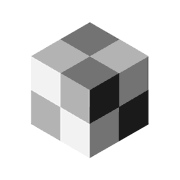
The eye perceives six different grey tones, although there are only actually four. Both the illusions are aided by good spatial imagination. Whether the body you see is convex or concave (a cube or the corner of a room, see also Spot 23) has no effect on the quality of the illusion.

When the three sides of the cube are separated, three luminance borders disappear. If you group the three sides together and light them by means of a single virtual beam of light, the illusions vanish with the exception of the local simultaneous contrast effects of the lowest processing level. However if you imagine the exploded view of the cube when looking at the separated sides, it is possible to recreate the illusion temporarily.

A similar result is achieved by looking at the development. If you see a flat abstract composition consisting of grey squares and take in the picture as a whole with wide open eyes, the illusions disappear almost totally. But if you see the cube that has just been folded flat, you reactivate the play of light and shade together with the grey tone illusions.
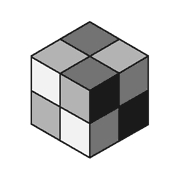
A thin black border has hardly any effect on the illusion.
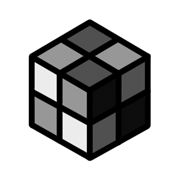
A thick black border, however, destroys the luminance limits. And the illusion is almost completely neutralised.
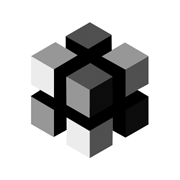
The individual elements of the cube are separated from one another. The adjoining surfaces are black. The illusions become very pronounced, since nothing has changed as far as the play of light and shade is concerned. The luminance limits at first only remained partially intact. The missing sections are formed as virtual edges, so that closed luminance limits are again created and corrections to the lighting are triggered.

Cube from the title spot for comparison.

The crumpled cube has the same grey tomes and the same topology. The deconstructivist distortion can cause you to see here an abstract, non-spatial figure without grey tone illusions. But if you wish to see the distorted original cube again, the play of light together with the illusions are perceived again with time. This experiment shows that our power of spatial imagination can have a positive influence on the grey tone illusions. With practice, the viewer can deliberately switch between various interpretations at will. The image thus becomes ambivalent for him and also provides evidence of the top-down input from the higher areas of visual perception.
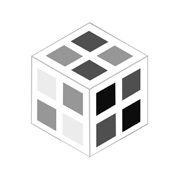
The white cube has regular even lighting. The twelve squares pasted on to it have the same grey tones as the pieces of the original cube. But there are no grey tone illusions because the differences between the grey tones are not read in conjunction with light and shade. The various grey tones here represent surface features which are not intended to be corrected by our visual system.
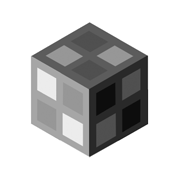
The three surfaces of the grey cube appear to have varying degrees of brightness. Three closed luminance limits arise. The three areas are lit differently in the extrastriary cortex in order to correct for the unwanted effects of the play of light and shade. The grey tone illusions are pronounced.
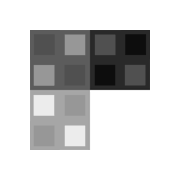
The grey tone illusions are barely reduced in the development because the luminance limits remain unchanged.
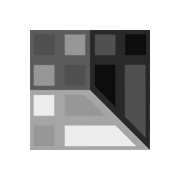
In the final picture, two side of the development are distorted to such an extent that the luminance areas once again have three common borders. The luminance effect is thus intensified. The grey tone illusions might even be more powerful than in the title spot although there is no 3D effect.
Our system of vision performs corrections on at least four levels of neural data processing in order to achieve and approximate grey tone constancy:
In the network of the retina, i.e. at the lowest level, contrasts sharpened (simultaneous brightness contrast). These local image corrections occur automatically everywhere two different grey surfaces come together. The receptor fields of the neurones involved, these are the areas of the retina, which are in a position to influence these neurones are still small for the time being.
In the primary visual cortex and its neighbouring areas the border lines are traced with a variety of automatic image processing tools, apparent edges are produced, figure and ground separated, transparent objects found and luminance limits drawn. The image is then illuminated afresh within these borders. The grey tone data undergo a change with this. The receptor fields are now considerably larger.
At the third processing level, the objects in the scene pictured are given spatial contours with information about depth. Stereoscopic vision can be involved in this or not. The results have a retroactive impact on figure-ground separation, luminance limits and thus also on grey tone parameters. The receptor fields have grown even larger.
It is at the fourth level that the cognitive processes finally occur, which call upon images stored in memory and which once again influence perception (for example of grey tones).
The entire process serves to correct and optimise putative object data to achieve a recognition or perceived objects that is as free of error as possible.